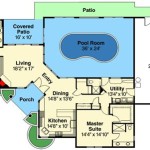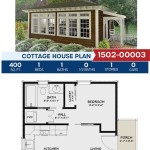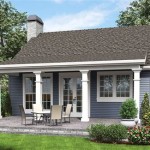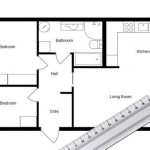Exploring the Enduring Appeal of One-Story Closed Floor Plans
The concept of a closed floor plan in a one-story home design dates back centuries and continues to hold relevance in contemporary residential architecture. This layout, characterized by distinct and separate rooms, offers a different living experience compared to the increasingly popular open floor plans. Understanding the nuances of a one-story closed floor plan involves examining its defining features, advantages, and suitable applications, allowing prospective homeowners and designers to make informed decisions about its appropriateness for specific needs and lifestyles.
Unlike open floor plans, which emphasize seamless transitions between spaces like the living room, dining room, and kitchen, a closed floor plan maintains defined boundaries. Walls and doorways create individual rooms, each serving a specific purpose. This compartmentalization results in a sense of privacy and separation that is highly valued by some homeowners. The appeal of this design lies in its ability to delineate functions and offer a more traditional living environment.
Privacy and Noise Reduction
One of the primary advantages of a one-story closed floor plan is the enhanced privacy it provides. With walls separating each room, individuals can enjoy more seclusion and personal space within their own homes. This can be particularly beneficial for families with varying schedules or those who value quiet time and concentration. For example, someone working from home can have a dedicated office space free from the distractions of household activity.
The inherent sound insulation offered by a closed floor plan is another significant benefit. Walls act as barriers to sound, minimizing noise transfer between rooms. This can be particularly important in homes with children, where playtime can be disruptive to those seeking rest or engaging in other activities. Similarly, the closed layout can help contain the noise of a home theater system or a loud kitchen appliance, preventing it from disturbing the entire household.
The layout also facilitates more formal entertaining. Separating the dining room from the living room allows for a more defined and elegant dining experience, minimizing the visibility of everyday living clutter. The walls also offer a physical and visual barrier, preventing odors from the kitchen from permeating the entire house. This creates a more controlled and refined atmosphere for social gatherings.
Defined Functionality and Organization
A closed floor plan inherently promotes a sense of order and organization. Each room is designed and designated for a specific purpose, making it easier to maintain cleanliness and manage clutter. This contrasts with open floor plans, where the lack of defined boundaries can sometimes lead to a sense of disorganization and visual chaos.
The separate rooms in a closed floor plan allow for more targeted heating and cooling. By closing doors to rooms that are not in use, homeowners can effectively manage energy consumption and reduce utility bills. This is particularly advantageous in larger homes or in regions with extreme climates. The ability to control the temperature in each room independently can contribute to significant energy savings over time.
Moreover, decorating a closed floor plan offers greater flexibility and creative control. Each room can be styled individually, reflecting the personality and preferences of the occupants. This allows for a more personalized and curated living environment. In contrast, open floor plans often require a more cohesive and consistent design aesthetic throughout the shared space.
Suitable Applications and Considerations
While a one-story closed floor plan offers several advantages, it's crucial to consider its suitability for specific lifestyles and needs. Families with young children who require constant supervision might find the separation of rooms less desirable than an open layout that allows for easy monitoring. Similarly, individuals who prefer a more social and interactive living environment might find the compartmentalized nature of a closed floor plan restricting.
The design also requires careful consideration of space utilization. Because walls occupy a significant portion of the floor area, a closed floor plan may feel smaller and more confined than an equivalent open floor plan. This is especially true in smaller homes. Maximizing natural light and employing strategic design elements can help mitigate this effect, but it requires careful planning and execution.
Furthermore, renovations in a closed floor plan can be more complex and costly than in an open layout. Removing or altering walls requires structural considerations and may necessitate professional expertise. This can limit the homeowner's ability to easily adapt the space to changing needs or preferences over time. Therefore, careful consideration of future needs and potential renovations is essential when choosing a closed floor plan.
Despite these considerations, the one-story closed floor plan remains a viable and attractive option for many homeowners. Its emphasis on privacy, noise reduction, and defined functionality appeals to those who value a more structured and traditional living environment. By carefully evaluating the advantages and disadvantages of this design, prospective homeowners can determine whether it aligns with their individual needs and lifestyle preferences.
The choice between a closed and open floor plan is ultimately a personal one. There is no universally superior design; the ideal choice depends on individual priorities and preferences. Understanding the inherent characteristics of each layout empowers homeowners to make informed decisions and create a living space that truly reflects their unique needs and aspirations. The enduring presence of the one-story closed floor plan in modern residential architecture underscores its continued relevance and appeal in a diverse and evolving housing market.

Traditional Homes With Closed Floor Plans Blog Eplans Com

Traditional Homes With Closed Floor Plans Blog Eplans Com

Traditional Homes With Closed Floor Plans Blog Eplans Com

Unique One Story House Plans Monster

We Re Making A Case For The Not So Open Floor Plans

Traditional Homes With Closed Floor Plans Blog Eplans Com

One Story Farmhouse Plan With Closed Foyer 1367 Sq Ft 801102pm Architectural Designs House Plans

Small One Story 2 Bedroom Retirement House Plans Houseplans Blog Com

40 X 55 2 200 Sf One Story House Plan Elevations The Escape

Must Have One Story Open Floor Plans Blog Eplans Com








